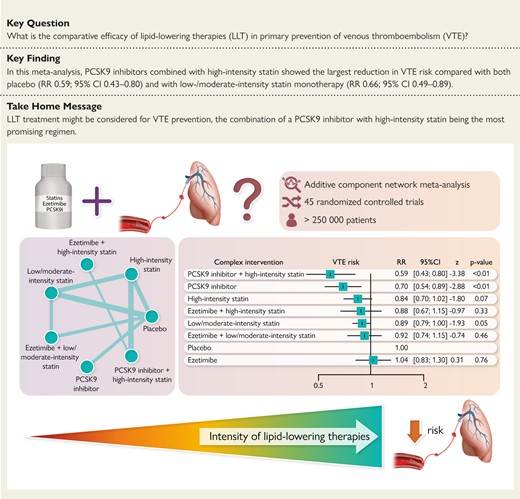-
Views
-
Cite
Cite
Ioannis T Farmakis, Konstantinos C Christodoulou, Lukas Hobohm, Stavros V Konstantinides, Luca Valerio, Lipid lowering for prevention of venous thromboembolism: a network meta-analysis, European Heart Journal, Volume 45, Issue 35, 14 September 2024, Pages 3219–3227, https://doi.org/10.1093/eurheartj/ehae361
Close - Share Icon Share
Abstract
Studies have suggested that statins may be associated with reduced risk of venous thromboembolism (VTE). The aim of the current study was to assess the evidence regarding the comparative effect of all lipid-lowering therapies (LLT) in primary VTE prevention.
After a systematic search of PubMed, CENTRAL, and Web of Science up until 2 November 2022, randomized controlled trials (RCT) of statins (high- or low-/moderate-intensity), ezetimibe, or proprotein convertase subtilisin/kexin type 9 inhibitors (PCSK9i) were selected. An additive component network meta-analysis to compare VTE risk during long-term follow-up across different combinations of LLT was performed.
Forty-five RCTs (n = 254 933 patients) were identified, reporting a total of 2084 VTE events. Compared with placebo, the combination of PCSK9i with high-intensity statin was associated with the largest reduction in VTE risk (risk ratio [RR] 0.59; 95% confidence interval [CI] 0.43–0.80), while there was a trend towards reduction for high-intensity (0.84; 0.70–1.02) and low-/moderate-intensity (0.89; 0.79–1.00) statin monotherapy. Ezetimibe monotherapy did not affect the VTE risk (1.04; 0.83–1.30). There was a gradual increase in the summary effect of VTE reduction with increasing intensity of the LLT. When compared with low-/moderate-intensity statin monotherapy, the combination of PCSK9i and high-intensity statin was significantly more likely to reduce VTE risk (0.66; 0.49–0.89).
The present meta-analysis of RCTs suggests that LLT may have a potential for VTE prevention, particularly in high-intensity dosing and in combination therapy.

Summary of trials included and effects of lipid lowering therapies (LLT) combinations against placebo, as the reference group, on VTE risk in the additive component network meta-analysis.





